On this page
Northwest TerritoriesThis page lists books about birds and birdwatching in the Canadian Northwest Territories.The books are arranged by publication date with the most recent at the top of the page.
CanadaFor bird books that cover all, or a large part, of Canada see the following pages:
Canada
North America
|
|
|
|
Birds of Western CanadaEditor: David M. Bird
Dorling Kindersley
2013
"Ideal for Canadian birdwatchers and bird lovers of every age! Each of these regional field guides are filled with page after page of magnificent close-up photographs and helpful full-page profiles of hundreds of commonly seen species. With an East / West division made at the 100th meridian (approximately Winnipeg) these handy books offer scientifically accurate and readable accounts of notable characteristics and information everything from behavior and habitat to nest construction and conservation status. Each profile also features diagrams of flight patterns and statistics of size, wingspan and lifespan. These invaluable reference guides are both detailed and accessible, with a user-friendly format that will make it easy for birders to enjoy either studying one species account at a time or browsing to make cross comparisons."
|
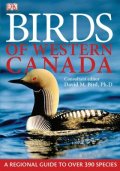 |
|
Gull and Tern Breeding Colonies on the North Arm of Great Slave Lake, Northwest Territories: 1986-2010Paul F. Woodard, Michael A. Fournier, and Myra O. Wiebe Robertson
Canadian Wildlife Service
2013
"Summarizes data and information on active larid breeding colonies collected between 1986 and 2010 on the portion of the North Arm west of Yellowknife. Most data were collected through ground surveys, with travel by boat, between mid June to early July. Information recorded at each colony included species, number of nests, clutch size, presence of chicks, and habitat characteristics."
|
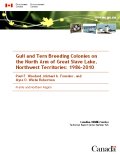 |
|
Arctic Shorebirds in North AmericaEditors: Jonathan Robert Bart and Victoria Helen Johnston
Studies In Avian Biology 44
Cooper Ornithological Society
2012
"Each year shorebirds from North and South America migrate thousands of miles to spend the summer in the Arctic. There they feed in shoreline marshes and estuaries along some of the most productive and pristine coasts anywhere. With so much available food they are able to reproduce almost explosively; and as winter approaches, they retreat south along with their offspring, to return to the Arctic the following spring. This remarkable pattern of movement and activity has been the object of intensive study by an international team of ornithologists who have spent a decade counting, surveying, and observing these shorebirds. In this important synthetic work, they address multiple questions about these migratory bird populations. How many birds occupy Arctic ecosystems each summer? How long do visiting shorebirds linger before heading south? How fecund are these birds? Where exactly do they migrate and where exactly do they return? Are their populations growing or shrinking? The results of this study are crucial for better understanding how environmental policies will influence Arctic habitats as well as the far-ranging winter habitats used by migratory shorebirds."
|
Buy from amazon.co.uk 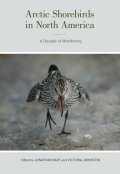
|
|
The Arctic: A Guide To Coastal WildlifeTony Soper
Bradt Wildlife Guides
Bradt
3rd edition
2012
"An engaging and beautifully illustrated guide to some of the most exciting wildlife in the world. This enchanting guide to the birds, animals and marine life of the Arctic Ocean and its polar fringes, is a fascinating and informative read. Visitors to the region can cruise the arctic coast in the company of blue whales and belugas, observe polar bears pursuing barnacle geese and seals, and experience a host of shorebirds and wildfowl gorging on the abundant food. Tony Soper's expert knowledge is richly supplemented with full-colour illustrations by award-winning wildlife artist Dan Powell. This revised edition includes a new section covering the distinct flora and fauna of the Bering Sea, an area about to see a significant increase in visitor numbers as a direct result of changes in the ice cover of the Arctic Ocean."
|
Buy from amazon.co.uk 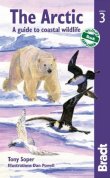
|
|
Boreal Birds of North America: A Hemispheric View of Their Conservation Links and SignificanceEditors: Jeffrey V. Wells
Studies In Avian Biology 41
Cooper Ornithological Society
2011
"Reaching from interior Alaska across Canada to Labrador and Newfoundland, North America's boreal forest is the largest wilderness area left on the planet. It is critical habitat for billions of birds; more than 300 species regularly breed there. After the breeding season, many boreal birds migrate to seasonal habitats across the United States, Mexico, the Caribbean, and Central and South America. This volume brings together new research on boreal bird biology and conservation. It highlights the importance of the region to the global avifauna and to the connectivity between the boreal forest and ecoregions throughout the Americas. The contributions showcase a unique set of perspectives on the migration, wintering ecology, and conservation of bird communities that are tied to the boreal forest in ways that may not have been previously considered."
|
Buy from amazon.co.uk 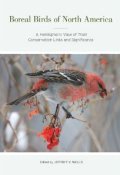
|
|
Key Migratory Bird Terrestrial Habitat Sites In The Northwest Territories And NunavutP.B. Latour, J. Leger, J.E. Hines, M.L. Mallory, D.L. Mulders, H.G. Gilchrist, P.A. Smith, D.L. Dickson
Occasional Paper Number 114
Canadian Wildlife Service
2008
"This report identifies 83 key terrestrial habitat sites for migratory birds in the Northwest Territories and Nunavut. These sites support at least 1% of the Canadian population of at least one migratory bird species (or, in some cases, subspecies). Sites also include marine and freshwater habitats where the value of the terrestrial habitat is intimately linked to the presence of aquatic habitats. Data for the identification of sites were drawn from existing published and unpublished reports and personal communications."
|
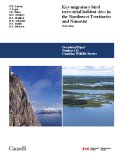 |
|
Return to Warden's Grove: Science, Desire, and the Lives of SparrowsChristopher Norment
University of Iowa Press
2008
"Based on three seasons of field research in the Canadian Arctic, Christopher Norment's exquisitely crafted meditation on science and nature, wildness and civilization, is marked by bottomless prose, reflection on timeless questions, and keen observations of the world and our place in it. In an era increasingly marked by cutting-edge research at the cellular and molecular level, what is the role for scientists of sympathetic observation? What can patient waiting tell us about ourselves and our place in the world? His family at home in the American Midwest, Norment spends months on end living in isolation in the Northwest Territories, studying the ecology of the Harris' Sparrow. Although the fourteenth-century German mystic Meister Eckhardt wrote, "God is at home, we are in the far country," Norment argues that an intellectual, emotional, and spiritual "far country" can be found in the lives of animals and arctic wilderness. For Norment, "doing science" can lead to an enriched aesthetic and emotional connection to something beyond the self and a way to develop a sacred sense of place in a world that feels increasingly less welcoming, certain, and familiar."
|
Buy from amazon.co.uk 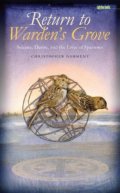
|
|
Productivity of Lesser Snow Geese on Banks Island, Northwest Territories, Canada, in 1995-1998Gustaf Samelius, James R. Hines Jr., Ray T. Alisauskas
Canadian Wildlife Service
2008?
"Objectives were to gather information on the number of nesting geese, nesting success, and gosling survival; evaluate the impact of weather and predation on the productivity of geese; and determine the impact of grazing by geese on plant communities."
|
 |
|
Travelling the DempsterJohn Neville
Trafford Publishing
2006
"Travel Canada's fabulous Dempster Highway with nature recordist John Neville, the Birdsong Man. Enjoy bird encounters from a nature recordist's point of view."
|
Buy from amazon.co.uk 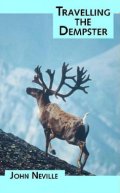
|
|
Geographic Distribution And Changes In Population Densities Of Waterfowl In The Northwest Territories, Canada, 1976-2003James R. Hines Jr., Bonnie Fournier
Canadian Wildlife Service
2005
"This report contains technical and scientific information from projects of the Canadian Wildlife Service. This report is intended to make available material that either is of interest to a limited audience or is too extensive to be accommodated in scientific journals or in existing CWS series. Demand for this Technical Report is usually confined to specialists in the fields concerned."
|
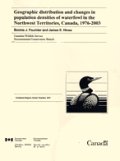 |
|
Boreal Forest of Canada and RussiaW.O. Pruitt and L.M. Baskin
Pensoft
2004
Bilingual parallel text: Russian and English
"Our planet's green halo is the circumpolar taiga or boreal forest. This forest is remarkably uniform in its climate, vegetation types and animal types. All life forms here have evolved adaptations to the long, cold and snowy winters, the short, hot and dry summers and the swiftly-changing seasons. The same genera and families of birds and mammals occur in this forest type in Eurasia and North America. Humans have invaded and exploited these northern coniferous forests differently in Canada and Russia. Although the history of human use has been different between the two countries the end results in both frequently have been catastrophic for vegetation, animals and some human groups. Such similarities and differences have been studied by biologists, human ecologists, anthropologists and other scientists at two research and teaching field stations in the taiga."
|
Buy from amazon.co.uk 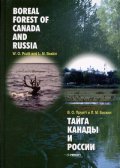
|
|
Key Marine Habitat Sites for Migratory Birds in Nunavut and the Northwest TerritoriesMark L. Mallory and Alain J. Fontaine
Occasional Paper Number 109
Canadian Wildlife Service
2004
"The Canadian Arctic contains much of Canada's coastal and marine zones, and these areas support tremendous numbers of marine birds. At the start of the 21st century, the Canadian marine zone is the subject of much concern as a result of a variety of anthropogenic threats. The Canadian Wildlife Service (CWS)is the federal agency responsible for the conservation of migratory bird populations and their habitats in Canada. As part of its mandate, CWS has produced this report identifying key marine habitat sites for migratory birds in Nunavut and the Northwest Territories. This report serves as a statement of CWS interest in marine areas where special wildlife conservation measures may be required, and it is offered as a guide to the conservation efforts of other agencies with interests in Nunavut and the Northwest Territories."
|
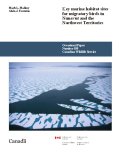 |
|
Canada's Boreal ForestJ. David Henry
Smithsonian Institution Scholarly Press
2002
"In Canada alone, the boreal forest (also called the taiga) covers more that 1.5 million square miles, fully one-third of the country and 20 percent of the entire North American continent. Terminating to the north with the treeless tundra, this region is inhabited and utilized by indigenous people and is home to unique populations of plants and animals found nowhere else on the planet. J. David Henry challenges the perception of the boreal forest as an "economic wasteland" by explaining how economically and ecologically valuable it is. He begins by answering some common questions about the region and explains its intricate geology. An in-depth examination follows of three factors that play an enormous role in shaping the complex life of the boreal forest: snow, forest fires, and peatlands. Henry looks at the dynamics of the region's vegetation and the evolution of its animals, and discusses the fascinating ten-year predator-prey cycle of snowshoe hares and Canadian lynx, one of the most famous examples of ecological interconnection. In Canada's boreal forest, loggers have clear cut an area the size of Great Britain. The final portion of the book examines initiatives from Scandinavia and Finland in order to offer alternatives to large-scale logging and mining, suggesting how humans can live and work in the boreal forest in a sustainable and responsible manner."
|
Buy from amazon.co.uk 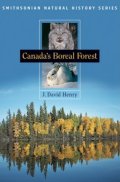
|
|
The Colonial Waterbirds of Great Slave Lake, Northwest TerritoriesJ. Sirois
Canadian Wildlife Service
1995
"We documented the diversity, abundance, distribution, and nesting chronology of the colonial waterbirds of Great Slave Lake in 1986-1995. We also reviewed all available historical information."
|
 |
|
Bird Surveys at McKinley Bay and Hutchinson Bay, Northwest Territories, in 1992D. Lynne Dickson
Canadian Wildlife Service
1993
|
 |
|
In Search of Arctic BirdsRichard Vaughan
Illustrations: Gunnar Brusewitz
Poyser
1991
The introduction of this book gives an overview of the Arctic and the forces that shape its bird populations and their biology. This is followed by chapters on the Innuit people, the whaling and discovery ships and the famous ornithologists who have investigated the area. Particular birds discussed in detail include the Gyrfalcon, Knots, Ross's Gull, geese, divers and Snowy Owls. The book also provides practical advice on visiting the Arctic.
|
Buy from amazon.co.uk 
|
|
Birds by the Dempster HighwayRobert Frisch
1982
"This guide is useful for identifying birds that can be found along the Dempster Highway, which runs from just east of Dawson City north to Inuvik near the Beaufort Sea."
|
Buy from amazon.co.uk 
|
|